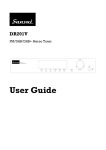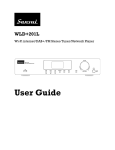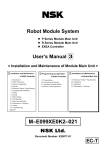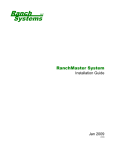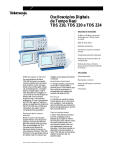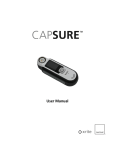Download Sansui SAP201V User guide
Transcript
SAP201V Integrated Stereo Amplifier with DAC User Guide Dear Valued Customer Thank you for deciding to purchase this Sansui product. This instruction manual will give you a general idea of how this device operates, as well as providing you with information on safety procedures and cleaning. In order to maintain this product in good condition, and to ensure it’s safe operation, please take a few minutes to read and carefully follow all the safety and operating instructions found in this manual. Please retain this instruction manual for future reference and pass it along with the device if handed over to a third party. Should you have any additional questions regarding the operation or installation of this device, or should any problems arise from its use, then please contact a specialized dealer or our service team for further information. We assume no liability for any damage incurred as a result of improper use resulting from failure to comply with the safety instructions found in this manual. Under such circumstances all claims under warranty will become null & void. We assume no liability for any consequential damage! This product is EMV-certified and complies with all European and National guideline requirements. A declaration of CE conformity has been established for this product. Certification has been documented and entrusted to the manufacturer Table of Contents 1. INTENDED USE .................................................................................................................................................. 5 EXPLANATION OF SYMBOLS .................................................................................................................................................. 5 2. SAFETY INFORMATION ...................................................................................................................................... 6 3. ACCESSORIES .................................................................................................................................................... 7 4. DESCRIPTION OF PARTS .................................................................................................................................... 8 FRONT PANEL ................................................................................................................................................................... 8 REAR PANEL..................................................................................................................................................................... 8 SANSUI RM200 REMOTE CONTROL HANDSET ........................................................................................................................ 9 5. SET UP AND CONNECTION TO OTHER DEVICES ................................................................................................ 11 CORRECT CONNECTION OF ANALOG RCA AUDIO CABLES ......................................................................................................... 11 CORRECT CONNECTION OF DIGITAL CABLES ........................................................................................................................... 11 CORRECT CONNECTION OF SPEAKERS ................................................................................................................................... 12 CONNECTING ANALOG AUDIO COMPONENTS ........................................................................................................................ 13 CONNECTING A TURNTABLE ............................................................................................................................................... 13 CONNECTING A CD OR SACD PLAYER .................................................................................................................................. 13 CONNECTING A NETWORK PLAYER/INTERNET RADIO/DAB+ TUNE ............................................................................................. 14 CONNECTING DIGITAL AUDIO COMPONENTS ......................................................................................................................... 14 CONNECTING A DEVICE VIA DIGITAL OPTICAL & DIGITAL COAXIAL CONNECTION ............................................................................ 14 CONNECTING THE POWER CABLE ........................................................................................................................................ 15 6. LISTENING TO AUDIO ...................................................................................................................................... 16 ADJUSTING THE TONE AND LEFT/RIGHT VOLUME BALANCE ...................................................................................................... 18 7. TROUBLESHOOTING AND ERROR MESSAGES ................................................................................................... 19 8. MAINTENANCE AND HANDLING ...................................................................................................................... 20 TRANSPORTING OR SENDING THE DEVICE .............................................................................................................................. 20 KEEPING THE EXTERNAL CASE CLEAN .................................................................................................................................... 20 CLEANING THE DEVICE ...................................................................................................................................................... 20 9. SPECIFICATIONS .............................................................................................................................................. 22 Before use Please read this instruction manual thoroughly before operating this device and retain it for further reference. Following and heeding all the information found in this instruction manual will maintain this product in good condition and ensure its safe operation. This instruction manual contains information on how to operate and maintain this device. Should a component require maintenance, servicing or repair, then please consult a qualified dealer or service technician. 1. Intended Use This device is an integrated stereo amplifier designed to have various hi-fi components connected to its inputs and a pair of stereo speakers connected to the speaker terminals. Please adhere to all of the safety information and instructions found in this instruction manual. Explanation of symbols An exclamation mark is intended to inform the user of important information, operation or maintenance instructions, or that special attention is required. This symbol is intended to alert you to the presence of unprotected live parts or components found within the product’s enclosure, or of dangerous connections that upon contact may be of sufficient magnitude to constitute a risk of electric shock. Cables intended for such connections should only be connected by qualified personnel or you should only use ready to connect cables. There are no user-serviceable parts found inside the device, therefore the device need never be opened. Page | 5 © Sansui UK 2012 SAP201V IB Ver 1.0 Rev 0.0 2. Safety Information The following safety and hazard warnings are not only for the protection of your device, but also serve as a protection against potential health hazards. Please take time to read the following instructions carefully. We assume no liability for personal or property damage resulting from the failure to comply with the safety instructions, or from improper operation or handling. Under such circumstances, all claims under warranty will become void - For safety and licensing (CE) reasons any unauthorized modification and/or changes to the device is prohibited and will void the warranty and all warranty claims. - Any persons operating, installing, setting up, or servicing this device must be trained and qualified accordingly, and observe these operating instructions. - Ensure that the device has been set up correctly by following all the instructions found in the instruction manual - This is a protection class II device. Make sure that the voltage supply of the power outlet used meets the required voltage specifications 230V/~50 Hz. - Power supply cables should be routed so that they are not likely to be walked on, squashed or pinched by items placed upon or against them. Pay particular attention to cords at plugs, power outlets, and at the point at which they exit from the device. Avoid exposing the cable to extreme heat or cold. Ignoring the above mentioned instructions could result in cable damage and present the danger of an electric shock. - - - - Keep packaging and protective foil away from children at all times to avoid the danger of suffocation. - The device should never come into contact with water or moisture. - To prevent the risk of fire or electric shock make sure that liquids, such as dripping or splashing water, rain or moisture, do not come in contact with the device and power supply plug - Operate this device in a moderate climate and never expose it to extreme temperatures, such as high humidity. - Condensation can build up suddenly if the device is brought from a colder area into a warmer area (e.g. when transporting). Should this happen, allow the device to warm up to room temperature first before using. - Care should be taken so that liquids do not come in contact with the interior, this is why containers containing liquids, e.g. buckets, vases or plants should never be placed anywhere near this product, including the power supply plug. This could not only damage the device, but also present a fire hazard. - It is imperative to avoid contact with moisture, e.g. never operate in the bathroom. - Make sure the device is properly ventilated during operation and never operate it in constricted areas, such as for example in a bookcase or shelf. Never block ventilation openings with magazines, tablecloths, curtains or similar. - Make sure the device is placed on a firm and stable surface. - Never place any sources of fire on top of or near the device and power supply plug (e.g. lighted candle). Should any obvious damage be seen on the device or on the connection cables, do not contact them in any way. Switch of the corresponding circuit breaker in the power distribution panel first, before carefully unplugging the power plug from the wall outlet. Do not operate the device further! Please contact or take it to a qualified service technician or specialty workshop. Please note that excessive sound pressure created when listening to loud volume levels with earphones or headphones can lead to permanent hearing damage. - Please adhere to the additional safety information found in the individual chapters of this instruction manual. - In order to completely cut off the power supply to the device, unplug the power plug from the wall outlet. Merely turning the device off with the ON/OFF button is not sufficient. Also make sure that power outlets are easily accessible. When connecting other devices, please refer to the safety and operating instructions found in the literature accompanying the device. - Please contact our technical hotline or a service technician for further information, should you be in doubt about device operation, safety or when making connections, or if any questions arise that are not explained within this manual. - Contribute to a better environment by using a designated recycling site for the disposal of packaging material. Always pull on the plug’s grips and never on the cable to remove it from a wall outlet. Unplug the device from the power outlet if not in use for a longer period of time. - For safety reasons, always unplug the device from the power outlet during thunder storms. - Eliminate potential tripping hazards by routing cables in such a way that no one can trip or stumble over them. - Never use the device, if the power cable or device is damaged. Page | 6 © Sansui UK 2012 SAP201V IB Ver 1.0 Rev 0.0 3. Accessories The following accessories are supplied with the system. Please check all these parts are present before proceeding. Please inform your dealer if any part is missing or damaged. 1 x Remote control handset 1 x mains power cable Page | 7 © Sansui UK 2012 SAP201V IB Ver 1.0 Rev 0.0 4. Description of parts Front Panel 1. 3.5mm stereo line in jack socket. Connect any audio source using a 3.5mm jack connection such as an MP3 player 7. Press to select AUX input. 8. Press to select TV input. 2. ¼” stereo headphone socket. 9. Press to select OPTICAL or COAX inputs. 3. Press to select LINE IN input. 4. Press to select PHONO input. 10. Input selector. Turn to control volume or press to enter tone control menu. 5. Press to select CD input. 6. Press to select NET-PLAYER input. 11. Power switch. Depress to switch unit on and depress again to switch off. Rear Panel 1. Power cable inlet: Plug in the supplied power cable here. 2. Right Speaker terminal posts. 3. Left Speaker terminal posts. 4. RCA Pre-amp Output connector. 5. RCA Input connectors, 6. Digital Optical Input. Connect an optical cable (not supplied) to connect to a digital output such as the optical output on a Sansui network player. 7. Digital Coaxial S/PDIF input. Connect a COAX cable (not supplied) to connect to a digital output such as the coaxial output on a SACD or CD player. 8. Phono ground terminal for connecting the ground connection from a turntable. Page | 8 © Sansui UK 2012 SAP201V IB Ver 1.0 Rev 0.0 Sansui RM200 Remote Control Handset Buttons 1-6 are for controlling the Sansui SAP201V amplifier 1 Switch amp power to Standby or power on from Standby 2 Reduce Volume 3 Increase Volume 4 Mute Volume 5 Scroll through the Input functions on amp 6 Scroll through the Tone functions on amp Buttons 7-11 are for controlling the Sansui CDD201V CD Player 7 Switch CD Player power to Standby or power on from Standby 8 Pause control 9 Stop button 10 Press to skip to previous track. 11 Play button 12 Press to skip to next track. Using the Remote Controller Point the remote controller toward the front of the unit, within the field shown in the drawing. - Do not expose the remote control sensor to strong light, such as direct sunlight or inverted fluorescent light. - Using the unit near equipment that emits infrared beams or with another remote controller may cause malfunctions. - Make sure that the audio rack does not have colored glass, as this could prevent the remote controller from functioning properly. - The remote controller will not function if there are obstacles between it and the remote control sensor. - Do not place objects such as books on top of the remote controller. Doing so could depress the buttons on the remote continually and drain the batteries. Page | 9 © Sansui UK 2012 SAP201V IB Ver 1.0 Rev 0.0 - Always follow the manufacturer's instructions when recharging rechargeable batteries. - Touching leaking or damaged batteries could cause skin burns. Use protective gloves suitable for handling such batteries. - Always ensure that the device has been turned off after use. - Always change/replace all batteries at the same time. - If required clean battery and device contacts before inserting, Inserting/changing batteries Remove the battery compartment cover carefully. Remove the used battery. Insert a new CR2025 lithium battery, observing the correct polarity as displayed inside the remote. Push in the cover until it clicks. Information on handling batteries and rechargeable batteries Please adhere to the following information when handling batteries and rechargeable batteries. - Keep batteries out of children’s reach. - Batteries are hazardous and do not belong in household waste. Ensure correct polarity when inserting batteries. - - Always remove batteries when the remote control is not in use for long periods of time. - Never leave batteries lying around unsupervised. If swallowed these could pose a choking hazard to children and pets. Seek emergency medical care immediately, should this happen. - Never expose batteries to extreme temperatures, such as sunlight, fire, ovens, etc. there is a risk of explosion! - Make sure that batteries are not dismantled, short-circuited or are thrown into fire. Never re-charge nonrechargeable batteries. There is a risk of explosion! Page | 10 © Sansui UK 2012 SAP201V IB Ver 1.0 Rev 0.0 5. Set Up and Connection to Other Devices This amplifier is designed to be connected to speakers for audio playback and other audio source devices such as a CD player or tuner. There are two ways of connecting: analog and digital. You may use either depending on the capability of the device you wish to connect. Correct Connection of Analog RCA Audio Cables - Pay attention to the plug colours and the left and right channels when connecting RCA audio cables. - Ensure a good connection by making sure to insert plugs completely. Failure to insert fully can cause noise or malfunctions. - To prevent unwanted interference keep audio cables as far apart from power cables as possible. Correct Connection of Digital Cables - There are two types of digital audio connection terminals o OPTICAL and o - COAXIAL Follow the instructions for the device you wish to connect to ensure the correct cable is used. Page | 11 © Sansui UK 2012 SAP201V IB Ver 1.0 Rev 0.0 Correct Connection of Speakers - There are two ways to connect speaker cables to the connection terminals on the amplifier. Either by connecting bare wire or by using cables with terminal connectors fitted. Bare Wire Method - Strip away approx. 5/8 inch (15 mm) of insulation from the ends of the speaker cables, and twist the bare wires tightly. - Loosen the screws on the speaker terminals, insert the wires, and screw the terminals tight. Caution - Make sure that the wires do not touch metal parts on the back panel or elsewhere. Terminal Connectors Method - For a much improved speaker cable connection it is advisable to use speaker cables with terminal connectors fitted such as banana plugs as shown on the right. - Connect the speakers as shown in the drawing below. Connect the positive speaker wire to the RED + positive terminal on the unit, and the negative speaker wire to the BLACK – negative on the unit. Page | 12 © Sansui UK 2012 SAP201V IB Ver 1.0 Rev 0.0 Connecting Analog Audio Components - When connecting any component to the amplifier please ensure the power is switched off before connection. Connecting a Turntable CAUTION - If the turntable has a ground wire, connect it to the unit's Phono GND screw. Note, however, that for some turntables, connecting the ground wire will increase the noise. If this happens, disconnect the ground wire. Connecting a CD or SACD player Page | 13 © Sansui UK 2012 SAP201V IB Ver 1.0 Rev 0.0 Connecting a Network Player/Internet radio/DAB+ Tuner Connecting Digital Audio Components - When connecting any component to the amplifier please ensure the power is switched off before connection. - There are two types of digital connection. Optical and Coaxial. See below Connecting a device via Digital Optical & Digital Coaxial Connection Page | 14 © Sansui UK 2012 SAP201V IB Ver 1.0 Rev 0.0 Connecting the Power Cable - Before connecting the power cord, connect all the other components. - Make sure the power switch is turned off on the unit before plugging or unplugging the power cable. - Connect the supplied power cord to the unit's AC INLET. Caution - Never plug the power cord into the outlet before connecting it to the unit. - If the power cord is plugged in, connecting or disconnecting it to/from the unit could cause electric shock. - Plug the power cord into a household power outlet. Page | 15 © Sansui UK 2012 SAP201V IB Ver 1.0 Rev 0.0 6. Listening to Audio - Turn on the component connected to the unit. - Press the POWER button on the front of the unit to turn it on. - The POWER indicator illuminates BLUE. Notes: Audio output will not begin until the electrical circuit stabilizes. The display shows Sansui during this time. Audio quality will stabilize about 10 to 30 minutes after the unit is turned on. - Press the input button to select the audio playback component. - Start playback on the component selected. Page | 16 © Sansui UK 2012 SAP201V IB Ver 1.0 Rev 0.0 - Turn the CONTROL knob to adjust the volume. - You can also control the volume using the volume buttons on the remote controller. - Press the MUTE button on the remote controller to set the volume to the minimum level. - When the volume is muted, the display indicator reads MUTE. - Press the MUTE button again to restore the original volume. - Mute mode will also be cancelled by adjusting the volume or pressing the POWER button. Notes: - When rotating the CONTROL knob the display ranges from -80dB to 0dB. Depending on the output signal level from the attached audio component, comfortable listening levels will vary. - When using the remote control to switch the unit to standby mode the POWER indicator light will change from BLUE to RED. To switch the unit on from standby simply press the power button on the remote control handset. Page | 17 © Sansui UK 2012 SAP201V IB Ver 1.0 Rev 0.0 - To listen with headphones, turn down the volume, and then insert the headphone plug into the HEADPHONE jack. When headphones are plugged in no sound will be heard from the speakers. Adjusting the Tone and Left/Right Volume Balance - Press the CONTROL knob to initiate the tone adjustment controls. - Each press of the CONTROL knob will cycle through BASS, TREBLE and BALANCE. - Turn the CONTROL knob to adjust each tone setting. - The last option in the cycle is LOAD DEFAULT?. Pressing the CONTROL knob again will reset the tone adjustment to normal. Page | 18 © Sansui UK 2012 SAP201V IB Ver 1.0 Rev 0.0 7. Troubleshooting and error messages The SAP201V is equipped with state-of-the-art technology and is safe to operate. Nevertheless, problems or malfunctions may occur. Before contacting Sansui customer support, refer to the following for possible solutions. PROBLEM No power when switched on No sound POSSIBLE SOLUTION - Wall socket not switched on or faulty - Plug not fully inserted into wall socket - Fuse in plug may have blown. - - Internal mains fuse has blown inside the unit, this will need to be replaced by a qualified service technician Power not turned on - Volume setting too low - Loudspeaker cables not connected - No input audio equipment is connected or is faulty - Correct audio input source not selected on front panel - Audio source input cables connected incorrectly or damaged - Audio input source faulty Loudspeaker cables connected incorrectly or damaged - Loudspeakers are faulty - Balance control switched to one side Audio input cables damaged or not correctly connected - CD player sited too close to TV Weak bass, diffused stereo image - Distorted sound - Speaker connections out of phase check + and – terminals are connected to corresponding terminals on both amplifier and loudspeakers Frayed wires may be touching on speaker terminals causing distortion No sound in one channel Loud buzz or hum Audio input source switches not - Bass and treble controls may be too high for loudspeaker specification. - Volume control may be set too high Internal fault would need servicing by a qualified service technician. - Check if the batteries have been inserted correctly. - If batteries are empty, replace them with new ones. - Remove any objects found between the remote control and the remote sensor. - Make sure the distance between the remote control and the device does not exceed 8 m Turn the unit off and then on again. working Remote control not working Buttons do not function (on the unit and/or - remote control) - As an alternative, turn the unit off, unplug it from the power outlet and plug in again. Any repairs other than those mentioned above are to be carried out solely by an authorised technician. Page | 19 © Sansui UK 2012 SAP201V IB Ver 1.0 Rev 0.0 8. Maintenance and handling Carry out a technical safety inspection on a regular basis, e.g. check if the power cable or housing has not been damaged. If there is reason to believe that the device can no longer be operated safely, then disconnect it immediately from the power supply and secure it against any unintentional operation. Carefully remove the power cable plug from the wall outlet and where applicable switch off the corresponding circuit breaker first. It can be assumed that safe operation is no longer possible, if: there is visible damage to the device or power cable, the device has become wet or water has been able to get inside. it has been stored for a long period of time under unfavorable conditions it has been dropped, exposed to rigorous transport conditions or otherwise damaged. Always adhere to the following safety instructions before cleaning and maintenance: Live parts may be exposed, if the covering is opened or parts are removed. - The device must be disconnected from the power supply source prior to service, maintenance or repairs. Repairs are only to be carried out by qualified personnel, who are familiar with the hazards involved and the relevant regulations. Transporting or sending the device Please retain the original box and the packaging material in case you need to transport or send the device out for maintenance at a later date. Please note that the device should be repacked in the original packaging. The box and packaging have been especially developed for this device in order to protect it during transport and against damage. Retain this instruction manual for future reference and where required pass it along with the device if handed over to a third party. It contains important information on initial operation and handling. Keeping the external case clean Never use volatile fluids near the device, as for example insect spray. Avoid letting the device come in contact with rubber or plastic products for longer periods of time. These could otherwise leave marks behind. Cleaning the device Unplug the power cable before cleaning. Always use a soft and dry cloth to clean the unit’s exterior. If the device is extremely dirty you can use a soft cloth, dampened with water or a mild cleaning solution to clean. Never use any abrasive or harsh cleaning agents (e.g. alcohol, benzene or thinners) as these could damage the controls, casing or any markings and labels found on the device. Page | 20 © Sansui UK 2012 SAP201V IB Ver 1.0 Rev 0.0 Important Notice Please note that electrical and electronic devices must never be disposed of in regular household waste! Consumers are legally obligated and responsible for the proper disposal of electronic devices by returning them to collection sites designated for the recycling of electrical and electronic equipment waste after the useful life of the device has come to an end. For more information concerning collection sites and correct disposal please contact your local authority or waste management company. The presence of the above symbol on a device, or its packaging or within the instruction manual indicates that the item must not be disposed of in normal unsorted municipal waste. In doing so you are fulfilling all recycling and disposal obligations and are optimising and contributing to a better environment. These disposal regulations apply to batteries and rechargeable battery disposals as well. Most batteries contain hazardous chemicals which can contaminate the environment and human health if they are discarded in ordinary household waste. According to legislation batteries are to be returned to the place of purchase or disposed of at a designated recycling site Page | 21 © Sansui UK 2012 SAP201V IB Ver 1.0 Rev 0.0 9. Specifications Rated output Power 40 W at 8 ohms, 2 ch driven, 1 kHz, 0.8 % THD (IEC) 50 W at 4 ohms, 2 ch driven, 1 kHz,0.8 % THD (IEC) Dynamic Power 150W THD (Total Harmonic Distortion) 0.08 % (1 kHz 1 W) Damping Factor 60 (Front'1 kHz'8 ) Input Sensitivity and Impedance 250 mV/47 k(LINE) 6.5 mV/47 k(PHONO) Output Level and Impedance 250 mV/47k(REC OUT) Phono Overload 60 mV (MM 1 kHz 0.5 %) Frequency Response 20 Hz-50 kHz/+1 dB-3 dB (LINE) +14 dB, -14 dB, 100 Hz (BASS) Tone Control +14 dB, -14dB, 10 kHz (TREBLE) +0 dB, -14 dB (BALANCE) Signal to Noise Ratio >85dB (LINE, IHF-A) 61 dB (PHONO, IHF-A) Speaker Impedance 4 ohm 8 ohm 16 ohm Digital Inputs OPTICAL 1 (Rear), COAXIAL 1 (Rear) Analog Inputs PHONO/CD/NET-PLAYER/AUX/TV (REAR) LINE-IN (FRONT) Analog Outputs REC OUT Headphones 1 x 1/4" (FRONT) Power Supply AC 230V, 50/60 Hz Power Consumption Max 250W Dimensions (WxHxD) : 430 x 80 x 283 mm Weight 6.3 kg NOTE: Specifications and design are subject to possible modifications without notice Page | 22 © Sansui UK 2012 SAP201V IB Ver 1.0 Rev 0.0 www.sansui.co.uk © Sansui UK 2012 SAP201V IB Ver 1.0 Rev 0.0






















